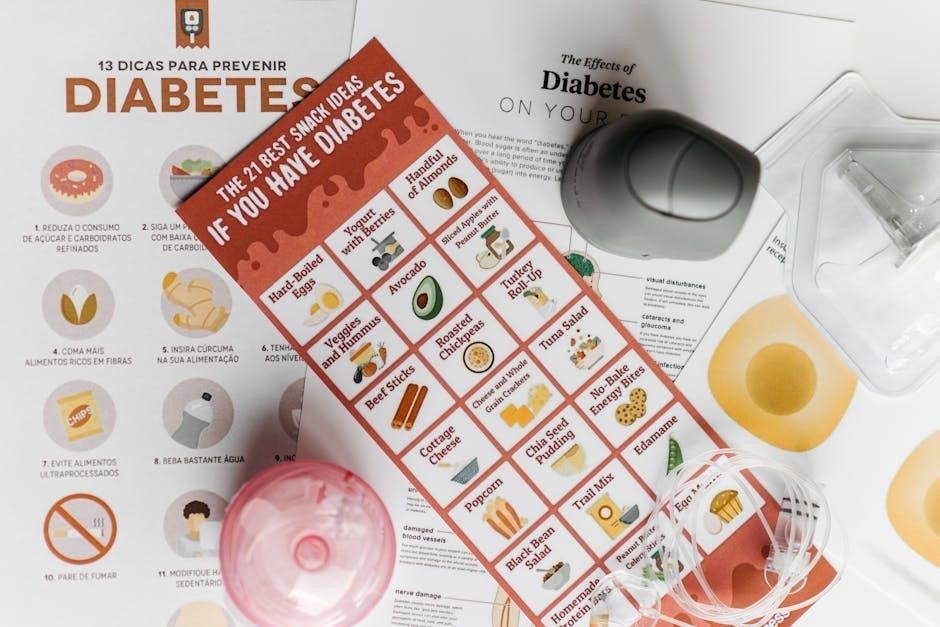Semaglutide Diet Plan PDF: A Comprehensive Guide
This guide explores Semaglutide and its impact, providing information on nutrition-related side effects. It offers an effective diet plan, emphasizing a personalized approach. This includes considerations, meal plans, and lifestyle integration. Downloadable PDFs with 7-day and 3-day sample meal plans are available.

Understanding Semaglutide and Diet
Semaglutide is a medication, known under brand names like Ozempic, primarily used for managing type 2 diabetes and, increasingly, for weight loss. It works by mimicking a natural hormone, GLP-1, which helps regulate blood sugar levels and reduces appetite. However, Semaglutide’s effectiveness is maximized when combined with a well-structured diet plan. The medication helps control hunger and cravings, making it easier to adhere to a calorie-controlled diet, essential for weight loss.
A comprehensive Semaglutide diet plan should focus on nutrient-dense, low-glycemic foods such as lean proteins, whole grains, non-starchy vegetables, and healthy fats. This combination supports steady blood sugar levels and provides sustained energy throughout the day. Understanding the interplay between Semaglutide and diet is crucial for optimizing results and minimizing potential side effects. This guide will explore the key elements of a Semaglutide diet plan, offering practical tips and sample meal plans to help you achieve your weight loss goals safely and effectively. Remember to consult with your healthcare provider before starting any new diet or medication regimen.
Key Considerations for a Semaglutide Diet Plan

When designing a Semaglutide diet plan, several key considerations must be taken into account to maximize its effectiveness and ensure safety. First and foremost, individual needs and preferences should be prioritized. A one-size-fits-all approach is unlikely to be successful, as dietary requirements and taste preferences vary significantly. Therefore, a personalized plan that incorporates your favorite healthy foods is essential for long-term adherence.
Secondly, focus on nutrient-dense, low-calorie options. Incorporate lean proteins, whole grains, non-starchy vegetables, and healthy fats to support satiety and provide essential nutrients. Portion control is also crucial, as Semaglutide can reduce appetite but doesn’t eliminate the need for mindful eating. Pay attention to serving sizes to avoid overconsumption.
Moreover, consider potential side effects, such as nausea or digestive discomfort. Adjust your diet accordingly, opting for smaller, more frequent meals and avoiding trigger foods. Staying hydrated is also vital, as dehydration can exacerbate side effects. Finally, consult with a registered dietitian or healthcare professional to create a tailored plan that aligns with your specific health goals and medical history. They can provide personalized guidance and monitor your progress to ensure optimal results and minimize risks.
Foods to Include in Your Semaglutide Diet
A successful Semaglutide diet plan should prioritize nutrient-rich foods that support weight loss and overall health. Lean protein sources are essential, including chicken breast, turkey, fish, and lean cuts of beef. These help maintain muscle mass and promote satiety, reducing cravings. Whole grains like quinoa, brown rice, and oats provide fiber and sustained energy, preventing blood sugar spikes.
Non-starchy vegetables such as broccoli, spinach, and bell peppers are packed with vitamins, minerals, and fiber, contributing to fullness without excessive calories. Healthy fats from avocados, nuts, and olive oil are crucial for hormone production and overall well-being. Low-fat dairy products like Greek yogurt and cottage cheese offer protein and calcium, supporting bone health.

Fruits, especially berries, provide antioxidants and essential nutrients while being relatively low in calories. Incorporating these foods into your diet helps create a balanced and sustainable eating plan. Remember to choose whole, unprocessed options whenever possible to maximize nutritional benefits and minimize added sugars and unhealthy fats. Variety is key to ensure you receive a wide range of nutrients and to prevent boredom, making it easier to stick to your diet plan long-term. Always consult with a healthcare professional for personalized dietary advice.
Foods to Avoid on a Semaglutide Diet
When following a Semaglutide diet plan, it’s crucial to limit or avoid certain foods that can hinder weight loss and exacerbate potential side effects. Processed foods, high in unhealthy fats, added sugars, and sodium, should be minimized. These include fast food, packaged snacks, and sugary drinks, which offer little nutritional value and contribute to weight gain.
Foods high in saturated and trans fats, such as fried foods, fatty meats, and many commercially baked goods, can negatively impact cardiovascular health and should be restricted. Refined carbohydrates, like white bread, pasta, and pastries, cause rapid blood sugar spikes and subsequent crashes, leading to increased hunger and cravings. Sugary beverages, including sodas, juices, and sweetened teas, are empty calories that contribute to weight gain and should be avoided.
Alcohol consumption should be limited as it can interfere with Semaglutide’s effectiveness and potentially worsen side effects. It’s also important to be mindful of portion sizes, even with healthy foods, to maintain a calorie deficit. By avoiding these foods, you can optimize the benefits of Semaglutide and promote sustainable weight loss. Prioritizing whole, unprocessed foods is essential for a successful and healthy Semaglutide diet plan. Always consult with a healthcare provider or registered dietitian for personalized guidance.
Sample 7-Day Semaglutide Meal Plan (PDF Available)

This sample 7-day Semaglutide meal plan provides a structured guide to help you kickstart your weight loss journey. It focuses on nutrient-dense, low-sugar, high-fiber, and high-protein options, aiming for approximately 1400-1600 calories per day. Remember to adjust portion sizes based on your individual needs, preferences, and any allergies you may have. This plan is designed to be a template, allowing for flexibility and personalization.
Each day includes balanced meals and snacks to keep you satisfied and energized. Breakfast options feature protein-rich choices like Greek yogurt with berries and nuts or eggs with whole-wheat toast and avocado. Lunch incorporates lean proteins such as grilled chicken salad or turkey breast with whole-grain bread and vegetables. Dinner options include baked fish with roasted vegetables or lean beef stir-fry with brown rice.
Snacks consist of healthy options like apple slices with peanut butter or a small handful of almonds. Hydration is essential, so aim to drink plenty of water throughout the day. This sample meal plan is available in PDF format for easy download and printing, allowing you to follow along conveniently. Always consult with your healthcare provider or a registered dietitian before starting any new diet plan, especially while taking Semaglutide, to ensure it aligns with your health needs and goals.
Sample 3-Day Semaglutide Meal Plan
This 3-day sample Semaglutide diet plan offers a quick start to incorporating healthier eating habits while taking Semaglutide. This sample plan focuses on balanced nutrition and aims for approximately 1400-1600 calories per day, packed with high protein, high fiber, low sugar, and low-fat options. However, it is vital to adjust the plan based on your unique needs, dietary preferences, and any potential allergies.
The meal plan includes a variety of delicious and nutritious choices. Breakfast options could include scrambled eggs with spinach and whole-wheat toast or Greek yogurt with berries and a sprinkle of nuts. Lunch might consist of a turkey and avocado wrap on whole-grain tortilla or a hearty salad with grilled chicken or chickpeas. For dinner, consider baked salmon with roasted vegetables or a lean ground beef stir-fry with brown rice.
Healthy snacks are incorporated to keep you feeling full and satisfied throughout the day. Examples include apple slices with almond butter, a handful of almonds, or a small serving of cottage cheese. Remember to drink plenty of water throughout the day to stay hydrated. A more comprehensive 10-day Semaglutide diet plan PDF is available for download, offering a wider variety of meal options and recipes. Always consult with a healthcare professional or registered dietitian before making significant changes to your diet, especially while on medication.
Designing a Personalized Semaglutide Diet Plan
Creating a personalized Semaglutide diet plan is crucial for optimizing results while on the medication. While general guidelines exist, tailoring the plan to your individual needs, preferences, and lifestyle increases adherence and effectiveness. Start by identifying your favorite healthy foods and incorporating them into your meal plan. Consider your daily routine, cooking skills, and any dietary restrictions or allergies.
A well-designed plan should include foods from all food groups, emphasizing low-glycemic, nutrient-dense options. Focus on lean proteins like chicken, fish, and beans, whole grains such as brown rice and quinoa, non-starchy vegetables like broccoli and spinach, and healthy fats from avocados and nuts. Pay attention to portion sizes and calorie intake, adjusting based on your weight loss goals and activity level. Keeping a food journal can help track your progress and identify areas for improvement.
It’s also essential to consider potential side effects of Semaglutide, such as nausea or decreased appetite. Adjust your meal plan accordingly, opting for smaller, more frequent meals and easily digestible foods. Working with a registered dietitian or nutritionist can provide personalized guidance and support in designing a sustainable and effective Semaglutide diet plan. Remember, consistency and adherence are key to achieving long-term success with Semaglutide and a healthy diet.
Importance of a Healthy Lifestyle Alongside Semaglutide
While Semaglutide can be a valuable tool for weight management and blood sugar control, it’s crucial to recognize that it’s not a magic bullet. Achieving sustainable, long-term health benefits requires integrating Semaglutide with a comprehensive healthy lifestyle. This includes adopting a balanced diet, engaging in regular physical activity, managing stress, and prioritizing sleep.
A healthy diet provides the necessary nutrients for optimal bodily function, supports weight loss efforts, and helps manage potential side effects of Semaglutide. Regular physical activity not only burns calories and promotes weight loss but also improves cardiovascular health, strengthens muscles and bones, and enhances mood. Managing stress through techniques like meditation or yoga can prevent emotional eating and support overall well-being.
Adequate sleep is essential for regulating hormones, boosting metabolism, and improving energy levels, all of which contribute to successful weight management. Combining Semaglutide with these lifestyle factors creates a synergistic effect, maximizing the medication’s benefits and fostering a healthier, more fulfilling life. Remember, Semaglutide is most effective when used as part of a holistic approach to health, empowering you to take control of your well-being and achieve lasting results.
Addressing Nutrition-Related Side Effects of Semaglutide
Semaglutide, while effective for weight management and blood sugar control, can sometimes lead to nutrition-related side effects. These can include nausea, vomiting, diarrhea, constipation, and decreased appetite. Understanding how to manage these side effects through dietary adjustments is crucial for a comfortable and successful treatment journey.
To combat nausea and vomiting, consider eating smaller, more frequent meals, avoiding greasy or spicy foods, and staying hydrated with clear liquids. For diarrhea, focus on easily digestible foods like bananas, rice, applesauce, and toast (BRAT diet), while avoiding dairy and high-fiber foods temporarily. If constipation occurs, increase your fiber intake gradually through fruits, vegetables, and whole grains, and ensure adequate fluid intake.
A decreased appetite may make it challenging to meet your nutritional needs. Prioritize nutrient-dense foods and consider adding protein shakes or smoothies to your diet. It’s essential to listen to your body and adjust your diet accordingly. Consulting with a registered dietitian can provide personalized guidance on managing these side effects and ensuring you receive adequate nutrition while on Semaglutide. They can help you create a tailored meal plan that addresses your specific needs and minimizes discomfort, allowing you to continue your treatment effectively.
Frequently Asked Questions About Semaglutide Diet Plans
Q: What is the best diet to follow while taking Semaglutide? A: The ideal diet is personalized, focusing on nutrient-dense, low-glycemic foods like lean proteins, whole grains, non-starchy vegetables, and healthy fats. It should also align with your preferences and lifestyle.
Q: Can I download a sample Semaglutide diet plan PDF? A: Yes, many resources offer free sample meal plans in PDF format. These provide a starting point, often including a 7-day or 3-day template with recipes and shopping lists.
Q: How many calories should I consume on a Semaglutide diet? A: Calorie needs vary, but many sample plans range from 1400-1600 calories per day. Adjust based on your individual needs, activity level, and weight loss goals. Consulting a dietitian is recommended.
Q: What foods should I avoid on a Semaglutide diet? A: Limit processed foods, sugary drinks, high-fat foods, and excessive carbohydrates. Pay attention to how your body reacts to different foods and avoid those that trigger side effects.
Q: How can I manage side effects like nausea on Semaglutide? A: Eat smaller, more frequent meals, avoid greasy or spicy foods, and stay hydrated. Consider bland foods like crackers or toast. If side effects persist, consult your doctor.